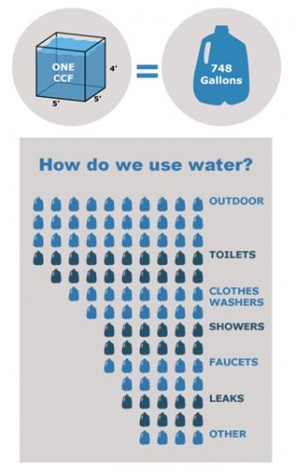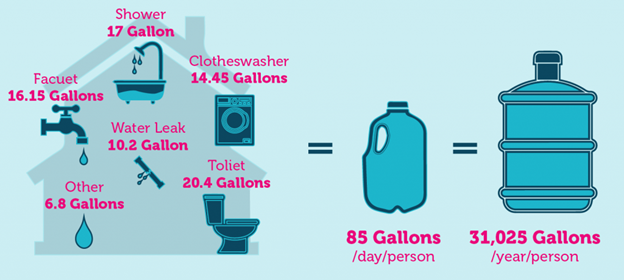CONSERVATION MEASURES
HERE ARE SOME LINKS TO ADDITIONAL CONSERVATION MEASURES:
• Install a 1.6 Gallon Ultra Low-Flow Toilet. Replace your old toilet, the largest water user in your home, and you'll save 3.5 to 4.5 gallons on every flush! If your home was built prior to 1992 and the toilet has never been replaced, it's very likely that you do NOT have a water efficient, 1.6 gallon-per-flush-toilet. (Check the date the toilet was made by lifting the lid at the top of the toilet tank and looking inside for the manufacturer's date imprint.)
• If you can't install a new toilet, put a plastic container or displacement bag in your toilet tank. Make one by placing an inch or two of sand or pebbles into a one quart or larger container. Fill the rest of the container with water, then put the cap back on and place the bottle in your toilet tank (safely away from the operating mechanism). The container will save on each flush without impairing the efficiency of the toilet.
• Check for leaks in your toilet. Toilets can have big leaks-up to 200+ gallons per day. Check for water leaking past the flapper valve at the bottom of the tank and into the toilet bowl. Put 10 drops of food coloring in the tank. Wait 10 minutes. Don't flush. If color shows up in the bowl, you've got a leak. Replace the flapper valve.
• Never use your toilet as a trash can. Flushing trash and cigarette butts down the toilet wastes gallons of water-not to mention the damage it does to your septic system.
• Replace your clothes washer, the second largest water user in your home. "Energy Star" rated front loading washing machines can use half the water that a standard, top loading washer uses. They also spin most of the water out, so laundry dries quicker, saving you $$ on both water and energy bills. Washing machines use up to 60 gallons per load, so wash full loads only.
• Run only full dishwasher loads, and save 300 - 800 gallons of water every month! Every load uses about 15 gallons. If you wash dishes by hand, don't leave the water running for rinsing.
• Replace regular showerheads with water conserving showerheads, and save 20 or more gallons for a five minute shower! Take shorter showers, and save 5 -10 gallons for every minute you cut back. In fact, take a short shower instead of a bath, and cut your water consumption by 2/3.
• Faucets. Use aerators on all faucets. Kitchen faucet aerators use less than 2.5 gallons per minute. Bathroom faucet aerators use less than 2 gallons per minute. • Tum off the water while brushing your teeth and save up to 3 gallons each time. • Don't let the faucet run while you clean vegetables-rinse them in a sink full of clean water.
• Tum off the water while you're shaving-fill the sink with a little water and rinse your razor. You can save up to 3 gallons. • Check faucets and pipes for leaks; even a small drip can waste more than 1500 gallons a month.
• Repair leaks immediately. Many silent leaks allow water- and your money-to go down the drain. Studies have shown homes can waste more than 10% due to leaks, which costs both you and the environment.
• Leaks in an irrigation system can be a huge waste of water. Fix irrigation system leaks quickly and check for pooling water or mud puddles. Inspect sprinklers and drip sprayers regularly for leaks during the day, since the optimal time to water is at night-when you cannot observe leaks. If you have an older irrigation system, over 50% and even more than 75% of the water can be lost to leaks.
• Turn off all water to your home (inside and outside) if you plan to be away for more than twenty-four hours. Residents have had undetected leaks which have incurred thousands of dollars in water bills.
• Never water native (pine and oak) trees. Plant drought resistant plants that don't require irrigation.
• Landlords: make your renters pay for water-they'll be motivated to save.
• Keep a bottle of drinking water in the refrigerator, so you won't have to run the tap to cool it.
• Use a broom instead of the hose.
• Wash your car in the city - not in Pine Hills!
Pine Hills Water Billing 1 unit =100 CCF (Centum cubic feet)
100 CCF = 748 gallons
Tier 1
 = 6 units
= 6 units
 up to 4,488 gallons
up to 4,488 gallons
Tier 2
 = 7-30 units
= 7-30 units
 5,236 to 22,440 gallons 1 unit = 748 gallons
5,236 to 22,440 gallons 1 unit = 748 gallons
Tier 3
 = over 30 units 23,188 gallons +
= over 30 units 23,188 gallons +
Usage recommendations per month 2 people 3 people
3 people 4 people
4 people
85 gallons per day 
 = 2550 gallons/month 6.82u
= 2550 gallons/month 6.82u  10.28u 13.64u
10.28u 13.64u
= 3.41 units/month/person
55 gallons per day* = 1650 gallons/month 4.41u  6.62u 8.23u
6.62u 8.23u
= 2.21 units/month/person
Goals: Tier 1 Tier 1 Tier 2
*In June 2018 California Assembly Bill 1668 and Senate Bill 606 changed target usage to
55-gallon per person per day.
Water Consumption per person
8 cups per day = 0.5 gallons per day = 15 gallons per month
EPA data 2018:
Shower 
 17 gallons
17 gallons
Washer 
 14.45 gallons
14.45 gallons
Toilet 20.4 gallons
Faucet 16.15 gallons
16.15 gallons
Other

 6.8 gallons
6.8 gallons
Water Leak 10.2 gallons
Reasons for High Usage
Broken lines – irrigation, water lines
Leaks – backflow valve, pumps, irrigation, faucets, toilets
Toilets: Slow leak = 30 gallons/day Medium Leak = 250 gallons/day = 7500 gallons/month = 10 units
Medium Leak = 250 gallons/day = 7500 gallons/month = 10 units
Water Stats
• The average family can waste 180 gallons per week, or 9,400 gallons of water annually, from household leaks. That's equivalent to the amount of water needed to wash more than 300 loads of laundry.
The average family can waste 180 gallons per week, or 9,400 gallons of water annually, from household leaks. That's equivalent to the amount of water needed to wash more than 300 loads of laundry.
• Running the dishwasher only when it's full can eliminate one load of dishes per week and save the average family nearly 320 gallons of water annually.
Running the dishwasher only when it's full can eliminate one load of dishes per week and save the average family nearly 320 gallons of water annually.
• Turning off the tap while brushing your teeth can save 8 gallons of water per day and, while shaving, can save 10 gallons of water per shave. Assuming you brush your teeth twice daily and shave 5 times per week, you could save nearly 5,700 gallons per year.
Turning off the tap while brushing your teeth can save 8 gallons of water per day and, while shaving, can save 10 gallons of water per shave. Assuming you brush your teeth twice daily and shave 5 times per week, you could save nearly 5,700 gallons per year.
• Letting your faucet run for five minutes while washing dishes can waste 10 gallons.
Letting your faucet run for five minutes while washing dishes can waste 10 gallons.



